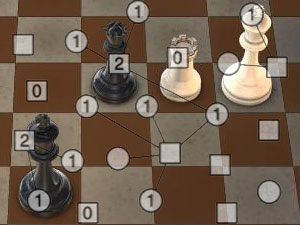

Some positions which humans had analyzed as draws were proved to be winnable the tablebase analysis could find a mate in more than a hundred moves, far beyond the horizon of humans, and beyond the capability of a computer during play.

The solutions have profoundly advanced the chess community's understanding of endgame theory. Tablebases have solved chess for every position with six or fewer pieces (including the two kings). Tablebases are generated by retrograde analysis, working backwards from a checkmated position. Typically the database records each possible position with certain pieces remaining on the board, and the best moves with White to move and with Black to move. Thus, the tablebase acts as an oracle, always providing the optimal moves. The tablebase contains the game-theoretical value (win, loss, or draw) of each possible move in each possible position, and how many moves it would take to achieve that result with perfect play. It is typically used by a computer chess engine during play, or by a human or computer that is retrospectively analysing a game that has already been played. In May 2006, Bourzutschky and Konoval discovered a KQN vs KRBN position with an astonishing DTC of 517 moves.An endgame tablebase is a computerized database that contains precalculated exhaustive analysis of a chess endgame position.

For example, For all three- to five-piece endgames and pawnless six-piece endgames, a complete list of mutual zugzwangs has been tabulated and published.Īnother case is the longest sequence of moves to reach a definite result, called 'Depth to conversion'. Working with a database to discover previously unknown facts is called ' data mining'.Ī number of interesting and surprising facts have indeed emerged. It is logically the same as proving a mathematical theorem by proving the complete set of individual cases covered by the theorem.Įndgame tablebases Īfter the chess engine has analysed the positions, the results are put into an endgame tablebase for easy retrieval by users. This is called proof by exhaustion or exhaustive proof. The best example is the analysis by computer chess engine of all possible positions with six pieces or fewer. Positions for which the result is certain, given best play, are technical positions. This is a certain win for White with best play Examples are mate with K+Q v K K+R v K K+2B v K K+B&N v K (this one is quite difficult). They are usually learned at the beginner stage. Basic checkmates īasic checkmates are positions in which one side has only a king and the other side has one or two pieces, enough to checkmate the opponent's king. Other endings are studied according to the pieces on board other than kings, e.g. For example, king and pawn endgames have only kings and pawns on one or both sides and the task of the stronger side is to promote one of the pawns. Generally, once a 'textbook' drawn position is reached the players will agree a draw otherwise they play on.Įndgames can be studied according to the type of pieces that remain on board. All endgames in master chess revolve around the borderline between winning and drawing. The ones that are drawn for certain may be legally drawn (mate could not happen) or drawn by chess experience (no sane defence could lose). On the other hand are positions which are drawn, or which should be drawn. On the one hand are positions which may be won by force. This is one of the main reasons for games to be drawn.Īll endgame positions can be put into two camps. Draws: in the endgame, a game may be drawn because there are too few pieces on the board to allow a player to win.There it can support its own pawns, attack the opponent's pawns, and oppose the opponent's king. The king may be brought towards the center of the board. Kings: may become strong pieces in the endgame.In the endgame, one thing players try to do is to promote a pawn by advancing it to the eighth rank. Pawns: during the endgame, pawns become more special.There are three main strategic differences between earlier parts of the game and endgame:


 0 kommentar(er)
0 kommentar(er)
